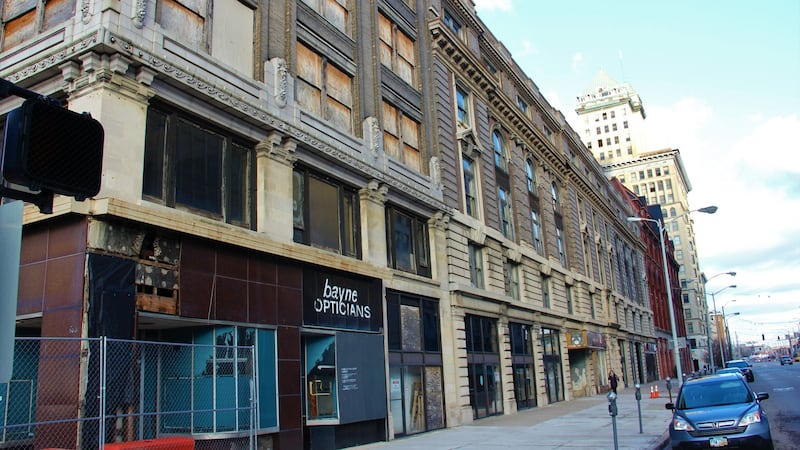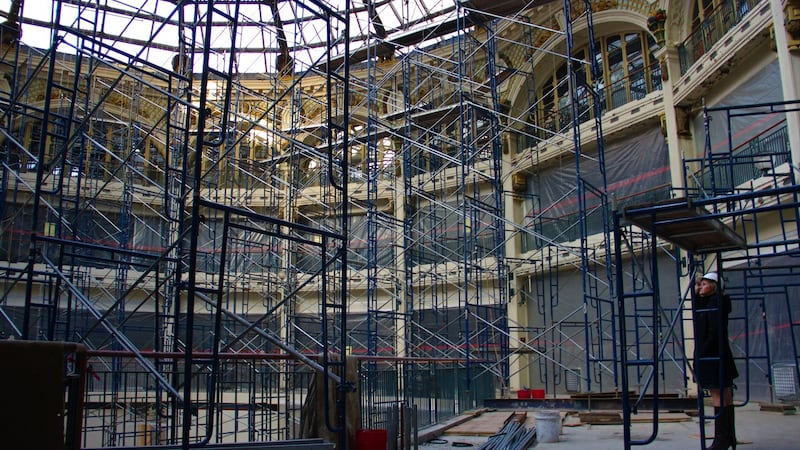Dayton, Ohio epitomised the hard times on which dozens of industrial midwest American cities had fallen. A manufacturing powerhouse until the 1980s, the city of 100,000 people nestled in western Ohio lost almost half its population between 1960 and 2010.
No structure represented Dayton’s fall quite like the hulking Dayton Arcade, a collection of nine buildings with Italian renaissance revival features, once one of the most architecturally elegant complexes in the American midwest. For almost a century, the Arcade served as the hub for shopping and afternoon tea meetings.
Inside its walls is a 21-metre-high rotunda, still decked out in Christmas decorations left over from the early 1990s. On several empty floors, dated glass-fronted shop spaces are littered with paint peelings. Water damage in the 30,000 square metre space is extensive as it has lain vacant for almost 30 years.

But recent events suggest the Arcade in Dayton and the wider American midwest are on the rise. Last year, the University of Dayton signed on to become anchor tenant at the Arcade where it will establish an “Ideation Center” for students and faculty.
In November, developers acquired eight of the nine properties that make up the complex, and are expected to invest €80 million in the initial development stage. Commercial spaces and housing units will make up a sizable part of the development and the city of Dayton has pledged a loan of $10 million to the project, its largest investment for 15 years.
"It's architecturally detailed, which in some ways is more difficult," says David Williams, senior director of development at Cross Street Partners, the project's lead developer. "Because of its past uses, it's compartmentalised in a way that's not useful today."
Cross Street Partners specialises in adaptive reuse projects, and has led regeneration works in Baltimore, St Louis and elsewhere.
Manufacturing hub
For more than a century, the midwest served as America's manufacturing hub, producing automobiles in Detroit, and steel, coal and corn in Pennsylvania, West Virginia and Illinois, much of which was transported via thousands of kilometres of canals. But as cheaper products from Asia surged into the US market in the 1970s, the factory belt found itself squeezed.
With no plan B, the midwest stumbled on as unions fought to retain jobs for which no work was needed. By the time the Great Recession of 2008 came, the Rust Belt was no longer just a term used by analysts, but a reality for dozens of cities and millions of people. Detroit, for example, lost almost a third of its population between 2000 and 2016.
These days, however, a rebound is in the making. A string of midwest metro areas is embracing knowledge economy practices, forgoing alternative but limited job-spinners other recovering regions of America have embraced, such as building convention centres and casinos.
The extent of the ongoing evolution is perhaps best illustrated by Tesla chief executive Elon Musk's suggestion that his company may buy several GM automobile plants in Ohio and elsewhere, following the announcement of their closure last November.
Irish business interests in the midwest are long established – a 650-seat theatre in Pittsburgh is adorned with the name of former Heinz chairman and CEO Tony O'Reilly – and Irish-owned companies are very much at the centre of the current revival. In August, Glanbia Nutritionals announced the opening of a €412-million cheese and whey facility in Michigan with two partners. One of two major US-based acquisitions made by Kerry Group last month is in Harrisonburg, Virginia. According to Enterprise Ireland's Chicago office, Dairymaster and others are also involved in the midwestern revival.
But it’s not just large, established corporations that are planting roots.
South Bend, Indiana
Kilkenny-headquartered fintech company TransferMate opened its first US office in Chicago in 2012, while in 2016, CupPrint, a Co Clare-headquartered custom-printed disposable cups company, leased a 1,500sq m space on the site of a former Studebaker assembly plant in South Bend, Indiana.
There’s little remarkable about the city of 100,000 people, better known in Ireland as the location of the high profile University of Notre Dame. Once a typical heavy industry hub, until the mid-20th century, it used the adjacent St Joseph River to transport agricultural equipment to Lake Michigan. But underneath the surface sits masses of fibre optic cables linking New York city and Chicago, America’s largest and third-largest cities respectively.
"I find, in South Bend, it's very easy to get things done. You have access to the business community very simply," CupPrint founder Terry Fox told Public Radio International last year.
One hundred and forty kilometres southeast in Indiana, Fort Wayne is another tertiary urban centre rising from the ashes. Fort Wayne is estimated to have lost 30,000 industrial jobs in the 1980s alone, a third in 1982 when the International Harvester company closed.
Not one midwestern city makes it into <em>Forbes </em>magazine's 2018 list of America's 25 fastest-growing cities
Today, following decades of decline, the city of 265,000 people is booming again. Where once there were empty, hulking steel production plants, there are now plans for innovation centres and start-up hubs. In November, the site of a former GE factory that once employed 40 per cent of the city’s workforce received a major local funding package to build an entire innovation district called Electric Works.
Referred to by the Wall Street Journal as "one of the most ambitious efforts to convert industrial complexes into modern downtowns", the 110,000-square-metre development will see dedicated office space for start-ups when it opens in two years.
"Electric Works will be a catalyst for new economic growth by consolidating activities around innovation and entrepreneurship," says Josh Parker, a partner at Cross Street Partners, the lead developer at Electric Works. "The presence of Parkview Health, Purdue Fort Wayne and IU School of Medicine provide a solid backbone for innovation and economic growth."
Fort Wayne
Even as other major cities in the region, such as Pittsburgh, have growing economies while losing population, Fort Wayne is both growing its economy and adding residents – a 25 per cent increase between 2000 and 2013.
However, shrugging off the ills of the past remains an ongoing struggle.
Not one midwestern city makes it into Forbes magazine's 2018 list of America's 25 fastest-growing cities. And five of the 10 US cities with the highest population losses are still in Ohio, Wisconsin and Michigan, according to 24/7 Wall St, a financial news site. A series of tax cuts in Ohio initiated in 2011 by the outgoing state governor, John Kasich, has left many cities and towns with hugely curbed spending power.
"[The revival is] happening much more in bigger cities than small ones," says Alan Ehrenhalt, the author of several books on the revival of American cities. "If yours is a state capital, has a major university or is a large city, you're more likely to be growing and innovating."
Downtown cores continue to be blighted by vacant buildings and anti-social activity at night, scenes that are hardly attractive to college students, entrepreneurs or the businesses that hope to attract and keep their talent.
And while start-ups and innovation hubs flanked by trendy cafes and restaurants have helped bring energy back to the streets of midwestern cities, they are not where the big money lies. It remains established legacy corporations – universities, health services groups and city authorities – that are ponying up the cash to fund multimillion dollar projects such as the Dayton Arcade and Fort Wayne’s Electric Works.
Change
And yet change, experts say, is unstoppable. Unemployment rates in Michigan, Ohio, Pennsylvania and Illinois all lie below 5 per cent.
The reason a number of the GM plants are set to close is because the models they manufacture, smaller cars such as the Chevrolet Cruze, are in less demand. That’s in part because consumers, with more spending capacity now than in many years – helped by the halving of oil prices since 2013 – are splashing out on more expensive SUVs.

Nor is auto manufacturing in the Midwest dead. A report by the Brookings Institution found that almost a third of industrial robots in operation in the US are found in just three midwestern states – Ohio, Michigan and Indiana – and many are deployed in the car manufacturing industry.
Back in Dayton, locals say the revival is in full swing.
"I would say absolutely. There's new breweries and tonnes of businesses and small shops popping up everywhere," says Jess Lucas, a bartender at Lucky's Taproom & Eatery, which opened in Dayton's Oregon district in 2011. "We have a big vegan/vegetarian menu that's popular."
The greenfield banks of the Great Miami River that flows through Dayton have been turned into metroparks that hold public events year-round. In November, a free bus service was launched to encourage residents and workers to move around more within the city centre.
Big picture-wise, Dayton’s population decline finally halted two years ago, indicating that more than 50 years of economic morose may be coming to an end.











